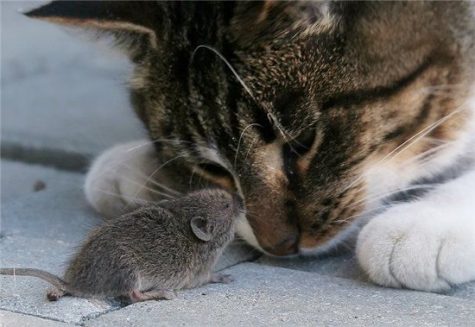The Science of Being Scared
Scientists believe that going wide-eyed was originally developed to alert others of a potential threat.
A jump scare in a horror film, getting called to the principal’s office, and skydiving from 10,000 feet are three very unique experiences united by one universal feeling: fear.
Fear holds an interesting place as one of the very few emotions that we both pursue and avoid. Especially around Halloween, with decorations and haunted houses up and running, the obsession that some people have with scary or thrilling experiences is easy to see.
Something in the way we’re made turns our once-survival instinct into a cheap rush, so much so that many actively seek fear out.
The obvious question is: what is it that makes a good scare so addicting? How has a typically unpleasant feeling become something to be desired?
Prominent psychologists such as John B. Watson and Paul Ekman have, since at least the 1850s, considered fear one of the most basic animal emotions along with anger, joy, and sadness. To see fear’s importance, it is only necessary to look at what happens without it.
When mice are infected with the Toxoplasma gondii parasite, their instinctual fear of cats is blocked. Not only do they become unafraid, chemicals released by T. gondii hardwire the rodents to seek out cats, even after they become parasite free!

These resolute rodents embody the “show no fear” mindset, unfortunately it often doesn’t end well for the mice.
Experiments have even seen mice walk over the faces of sleeping cats, with no regard for their own safety.
Although this type of biological mind control may be extreme, how animals and humans override the instinct of fear is a major topic of discussion across the sciences. In humans especially, the reasons vary widely.
One compelling explanation is the idea that humans overcome their feelings of fear most often for reasons of social standing, similar to how males in the animal kingdom will create “displays” in order to attract a mate. Just like a bighorn ram battling other contenders, I might go into a haunted house or to a scary movie to put on my own display of sorts.
This particular analogy is supported by several studies which confirm that, in fact, males are much more drawn to horror movies and extreme sports than female counterparts. This feeling of gratification, of conquering a task, could be interrelated with the competition males must face in the animal kingdom.

Competitions like these distinguish the successful males from the crowd
For those sorts of conflicts, where succumbing to your fears would be counterproductive, it makes sense that your brain would override that set of instincts in favor of another. In humans, the motivations remain the same. Saying no to the midnight screening of Ouija or trick-or-treating at the house with good decorations is akin to backing out of a brawl…or at least it feels that way.
Some, however, including Frank Farley of the American Psychological Association, think that the answer may be a bit more intuitive.
“Sky divers will tell you it’s the thrill, the rush, and a little element of fear that motivates them to push themselves to the extreme,” Farley says. “There’s almost nothing else that can match it in terms of the incredible sensory experience that the body is put through.”
Those with a thrill-seeking personality naturally gravitate towards shocking, even terrifying experiences in order to reach a high. Placing yourself in a controlled environment (like a haunted house or in a skydiving course) where the risk is minimal but the adrenaline rush is real can feel like being on a drug.
Besides adrenaline, your brain also triggers some interesting effects during a truly jolting experience. SCAD diving, which stands for Suspended Air Catch Device, is one thrill ride which reportedly causes time to slow down.
SCAD diving is essentially bungee jumping without a bungee. Divers hang facing upwards, suspended 150 feet in the air over a net. Suddenly, the line is severed, and they fall over a hundred feet into the net below.

SCAD divers most often use a setup such as the one above. Before you ask, there are no reported SCAD diving fatalities yet
Divers, however, were reporting something almost supernatural. As they fell, time seemed to slow, and SCAD divers consistently reported falling more than triple the actual time.
David Eagleman, professor of Baylor University, studied this phenomenon and has arrived at a conclusion. The slowing is thought to be caused by a trick of the brain, where the distressing circumstances trigger immense electrical activity in a very short period of time. The after-effects may last for hours, and similar effects on a smaller scale may explain part of the draw of thrilling activities, such as street racing or paintball.
Still other researchers believe that seeking a terrifying rush is simply youth pushing the envelope of what is acceptable, which serves to explain why adolescents in particular are so prone to thrill-seeking behavior.
Psychologist Leon Rappoport says, “There’s an attraction to their ‘forbidden’ nature, in the same way that many adolescents want to know what it’s like to drink too many beers, smoke cigarettes, or drive their car too fast.”
Dangerous and scary things are often, understandably, kept away from kids until they are older. Being willing to go to that R-rated movie horror flick or into the haunted house this Halloween is not only seen as a sign of bravery, but of maturity too. Halloween is the time when many kids push the boundary of what is allowed by their parents, and doing spooky or scary things is certainly a large piece of that.
Whether it’s a hardwiring of the brain, an alpha-male reflex, rebellious youth, or just good ol’ fashioned adrenaline, there’s no denying that scary things can be somewhat addictive.
Regardless of what theory of fear you believe, what’s not controversial is that there will be plenty of kids getting a healthy dose of fear this October 31st. Happy Halloween!
Have a scary experience you think is worth sharing? Tell us in the comments section below!








